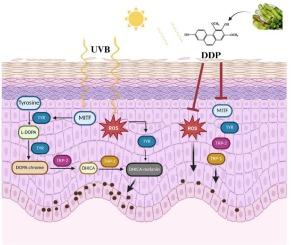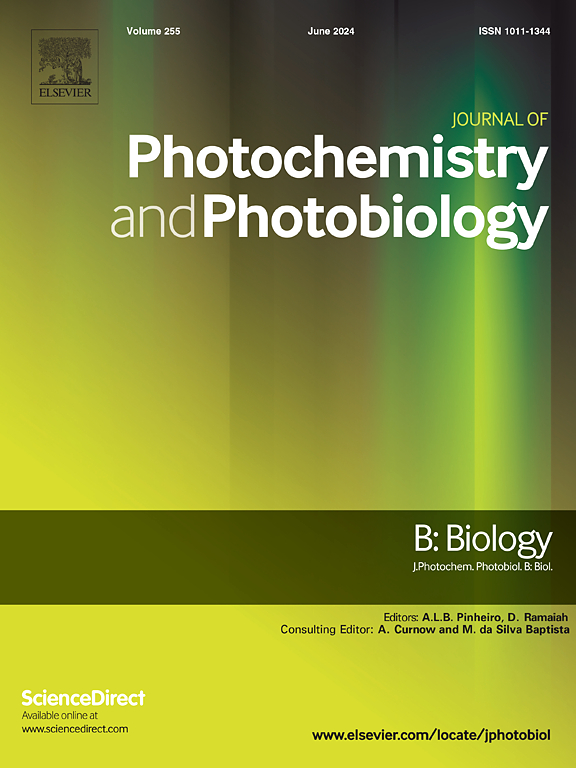3, 7-dihydroxy-2, 4-dimethoxyphenanthrene protects against UVB-induced skin hyperpigmentation via antioxidant and anti-melanogenic mechanisms
IF 3.7
2区 生物学
Q2 BIOCHEMISTRY & MOLECULAR BIOLOGY
Journal of photochemistry and photobiology. B, Biology
Pub Date : 2025-10-13
DOI:10.1016/j.jphotobiol.2025.113277
引用次数: 0
Abstract
Background
Excessive reactive oxygen species (ROS) produced by UVB radiation can disrupt the normal redox balance, leading to oxidative cellular damage as well as triggering melanin synthesis by melanocytes. Currently, natural active substances are emphasized in UV protection research. This study explored the protective effect of 3, 7-dihydroxy-2, 4-dimethoxyphenanthrene (DDP), a bioactive compound from Dendrobium lindleyi Stendel, against UVB-induced skin hyperpigmentation and examined its specific mechanism.
Methods
To evaluate the anti- melanogenic and antioxidant activities of DDP in vitro, molecular docking was used to predict the binding conformation of DDP to tyrosinase (TYR) and melanocortin 1 receptor (MC1R). Subsequently, CCK8 and cell live/dead staining were used to screen the safe concentration range. B16-F10 cells were treated with different doses of DDP before UVB light irradiation and before α-melanocyte-stimulating hormone (α-MSH) induction, and the evaluation of cells included determination of melanin content, Western blotting analysis, TYR activity assay, ROS assay, DPPH• and ABTS•+ radical scavenging assays. A brown guinea pig model was used to further evaluate the protective effect of DDP on UVB-induced skin pigmentation in vivo, and compared with commercial skin care products.
Results
In the present study, Molecular docking showed that DDP binds to TYR and MC1R better than Kojic Acid. DDP was found to possess excellent anti-melanogenic and antioxidant activities in vitro. DDP was effective in alleviating skin melanin accumulation induced by UVB irradiation without inflammatory side effects.
Conclusions
DDP protects against UVB-induced skin hyperpigmentation via antioxidant and anti-melanogenic mechanisms.

3,7 -二羟基- 2,4 -二甲氧基菲通过抗氧化和抗黑素机制防止uvb诱导的皮肤色素沉着。
背景:UVB辐射产生过多的活性氧(ROS)会破坏正常的氧化还原平衡,导致细胞氧化损伤,并触发黑色素细胞合成黑色素。目前,天然活性物质是防紫外线研究的重点。本研究探讨了来自林氏石斛的生物活性化合物3,7 -二羟基- 2,4 -二甲氧基菲(DDP)对uvb诱导的皮肤色素沉着的保护作用,并探讨了其具体机制。方法:采用分子对接方法预测DDP与酪氨酸酶(TYR)和黑素皮质素1受体(MC1R)的结合构象,评价DDP的体外抗黑素生成和抗氧化活性。随后采用CCK8和细胞活/死染色法筛选安全浓度范围。在UVB光照射前和α-MSH诱导前分别用不同剂量的DDP处理B16-F10细胞,对细胞的评价包括黑色素含量测定、Western blotting分析、TYR活性测定、ROS测定、DPPH•和ABTS•+自由基清除测定。采用褐豚鼠模型进一步评价DDP对uvb诱导的皮肤色素沉着的体内保护作用,并与市售护肤品进行比较。结果:在本研究中,分子对接显示DDP与TYR和MC1R的结合优于曲酸。体外实验发现DDP具有良好的抗黑色素生成和抗氧化活性。DDP能有效缓解UVB照射引起的皮肤黑色素积累,无炎症副作用。结论:DDP通过抗氧化和抗黑素生成机制对uvb诱导的皮肤色素沉着起到保护作用。
本文章由计算机程序翻译,如有差异,请以英文原文为准。
求助全文
约1分钟内获得全文
求助全文
来源期刊
CiteScore
12.10
自引率
1.90%
发文量
161
审稿时长
37 days
期刊介绍:
The Journal of Photochemistry and Photobiology B: Biology provides a forum for the publication of papers relating to the various aspects of photobiology, as well as a means for communication in this multidisciplinary field.
The scope includes:
- Bioluminescence
- Chronobiology
- DNA repair
- Environmental photobiology
- Nanotechnology in photobiology
- Photocarcinogenesis
- Photochemistry of biomolecules
- Photodynamic therapy
- Photomedicine
- Photomorphogenesis
- Photomovement
- Photoreception
- Photosensitization
- Photosynthesis
- Phototechnology
- Spectroscopy of biological systems
- UV and visible radiation effects and vision.

 求助内容:
求助内容: 应助结果提醒方式:
应助结果提醒方式:


